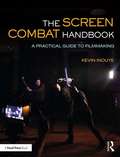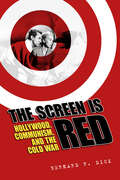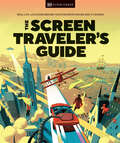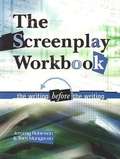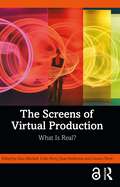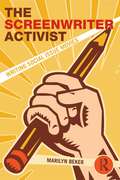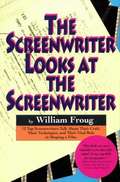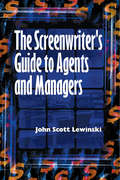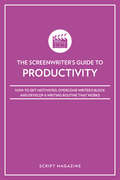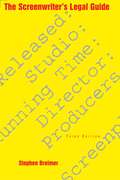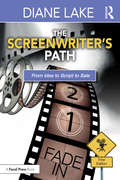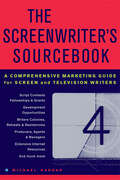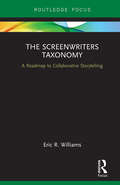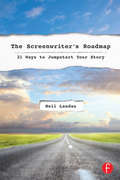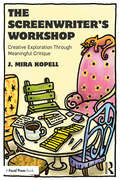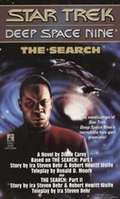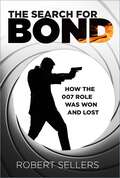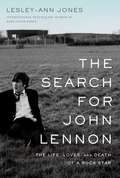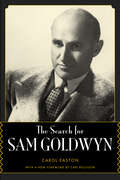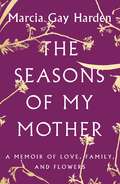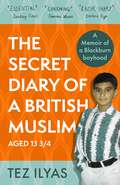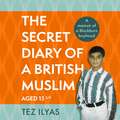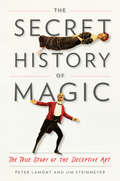- Table View
- List View
The Screen Combat Handbook: A Practical Guide for Filmmakers
by Kevin InouyeThe Screen Combat Handbook is an essential guide to navigating the unique challenges of putting combat on screen. Explore the process from the early stages of preproduction planning all the way through to editing and sound design, and everything in-between. This book uses practical instruction, examples, interviews, and illustrations to show how to plan, shoot, and assemble safe and effective fight sequences. It includes sections on thoughtful and practical design choices in set, wardrobe, props, and effects, preproduction planning, on-set protocol, fight choreography and coordination, shot planning and technical tricks, acting choices, effective cinematography, and impactful editing and sound design. It provides an invaluable resource for all those involved including directors, fight coordinators, actors and stunt players, and any filmmaker attempting to shoot an exciting action scene safely. Whether working on a no-budget indie production or on a professional set, this is your ultimate guide to screen combat and fight choreography.
The Screen Is Red: Hollywood, Communism, and the Cold War
by Bernard F. DickThe Screen Is Red portrays Hollywood's ambivalence toward the former Soviet Union before, during, and after the Cold War. In the 1930s, communism combated its alter ego, fascism, yet both threatened to undermine the capitalist system, the movie industry's foundational core value. Hollywood portrayed fascism as the greater threat and communism as an aberration embraced by young idealists unaware of its dark side. In Ninotchka, all a female commissar needs is a trip to Paris to convert her to capitalism and the luxuries it can offer. The scenario changed when Nazi Germany invaded the Soviet Union in 1941, making Russia a short-lived ally. The Soviets were quickly glorified in such films as Song of Russia, The North Star, Mission to Moscow, Days of Glory, and Counter-Attack. But once the Iron Curtain fell on Eastern Europe, the scenario changed again. America was now swarming with Soviet agents attempting to steal some crucial piece of microfilm. On screen, the atomic detonations in the Southwest produced mutations in ants, locusts, and spiders, and revived long-dead monsters from their watery tombs. The movies did not blame the atom bomb specifically but showed what horrors might result in addition to the iconic mushroom cloud. Through the lens of Hollywood, a nuclear war might leave a handful of survivors (Five), none (On the Beach, Dr. Strangelove), or cities in ruins (Fail-Safe). Today the threat is no longer the Soviet Union, but international terrorism. Author Bernard F. Dick argues, however, that the Soviet Union has not lost its appeal, as evident from the popular and critically acclaimed television series The Americans. More than eighty years later, the screen is still red.
The Screen Traveler's Guide: Real-life Locations Behind Your Favorite Movies and TV Shows
by DKPut yourself in the movie! Step inside dozens of real-life locations with this gloriously geeky, map-filled compendium.Locations are everything. They transport us to far-flung worlds and dystopian futures, and provide the backdrop to intergalactic battles and rampaging monsters. Our most obsessed-about stories would be nothing without them.Meticulously researched and compiled by self-proclaimed superfans and travel experts, The Screen Traveler&’s Guide maps the real-life locations behind your favorite shows and scenes. Follow the Avengers&’ battle of New York, discover the Croatian location for Game of Thrones&’ King&’s Landing, find out how New Zealand transformed into Lord of the Rings&’ Middle Earth, uncover exactly where the magical world of Harry Potter is set – and much more.Along the way, you&’ll discover the landmarks to avoid during an alien invasion, the strangest location stand-ins (did you know, for example, that Liverpool stood in for Brooklyn in Captain America?), the place that&’s doubled as more countries than any other, and lots of travel inspiration from your pop culture cornerstones. Welcome to the ultimate travel guide for every screen geek.
The Screenplay Workbook: The Writing Before the Writing
by Jeremy Robinson Tom MungovanThis perforated-page workbook for students learning to write screenplays includes numerous worksheets, charts, and fill-in lists designed to help students focus on essential aspects of the screenplay. Worksheets are provided for concept creation, character development and relationships, plot structure, plot points, character arc, and scenes. Online resources are listed and described. The authors are screenplay writers. Annotation (c)2003 Book News, Inc. , Portland, OR (booknews. com)
The Screens of Virtual Production: What is Real?
by Sean Redmond Lienors Torre Sian Mitchell Colin PerryThis book is the first dedicated edited collection that explores the virtualisation of screen-making processes from pre-production to post-production, while attuning to the aesthetic, ideological and performative contexts upended by these integrated technologies. This book explores what is real in virtual production, as a provocative one, implicitly drawing on the philosophies of the moving image and the recent work on new forms of post-human perceptual realism.This edited collection is divided into the following four themed sections. Section One, It’s Always Been Real: Contemporising Virtual Production, addresses the histories of film realism in relationship to visual technologies, providing both a theoretical and philosophical ‘anchor’ point for the collection, and a necessary genealogy. Section Two, The Body Becomes You: Performing Virtual Production, examines the transformation that occurs in immersive virtual worlds, while also exploring how the body is itself virtualised. Section Three, Skin Deep: Gazing with Virtual Production, addresses the way race, ethnicity, gender and environment are supposedly equalised, and yet are still found to reproduce the colonised looking regimes of western, mainstream screen culture. Section Four, Whose Work? Labouring with Virtual Production, draws together writing that examines the way production processes have been transformed, affecting not only work patterns but also the way aesthetics, form and function, operate.This book encompasses many production themes and will appeal to media students and professionals interested in the production of film.
The Screenwriter Activist: Writing Social Issue Movies
by Marilyn BekerHotel Rwanda. Philadelphia. Silkwood. Some of the most important films ever made have tackled real-world social issues, from genocide to homophobia to corporate greed. As storytellers, activist screenwriters recognize that social issues make great stories that can be gut-wrenching, heart-tugging, funny, tragic, and interesting to watch. The Screenwriter Activist helps screenwriters tell those stories in compelling, non-preachy, and inspiring ways. The Screenwriter Activist is an in-depth, practical guide, appropriate for students in intermediate or graduate screenwriting courses in Film and English Programs as well as professionals who want to write a movie that can make a difference in the world. Using examples from classic and recent popular films, The Screenwriter Activist: Explores the motivation and sensibility a screenwriter needs to embark on a social issue project Gives techniques for choosing compelling subjects Provides historical context for social issue movies Explains how characters legitimize social issue themes Puts forward specific models for structuring advocacy screenplays Lays out a roadmap for how screenwriters can get a social issue movie made If you care deeply about social issues and recognize that films can be highly effective platforms for motivativng audiences to civic involvement and social action, this is the one screenwriting book you need to read.
The Screenwriter Looks at the Screenwriter
by William FrougTwelve of Hollywood's top screenwriters discuss their craft and their lives, including: Johnson 'Grapes of Wrath', Diamond 'Some Like It Hot', Henry 'The Graduate', and Lardner 'M*A*S*H'.
The Screenwriter Within: How to Turn the Movie in Your Head into a Salable Screenplay
by D. B. GillesIf you've ever dreamed of writing a screenplay,The Screenwriter Withinis the book for you. Insightful, inspirational, and wildly irreverent, it takes you through all the stages of the writing process, using references to hit movies and the author's personal experience to show you how to: Turn everyday events into big-screen successes Find the best stories to turn into screenplays Develop strong characters Write compelling dialogue Find your niche as a screenwriter . . . and much more.
The Screenwriter's Guide to Agents and Managers
by John Scott LewinskiThe lessons to be learned from this helpful guide show aspiring screenwriters, television writers, and novelists how to catch an agent's eye and develop a successful scriptwriting career. Step-by-step instructions reveal how to get around the "Catch 22" of the trade-that you can't get an agent until you've sold a script. Interviews with prominent agents and managers disclose how the power brokers choose material, what kinds of writers command their attention, and what they expect from the writers they sign on. Tips on how to write a winning spec script, how to word an effective query letter, how to forge a sound relationship with reps, and other invaluable advice fill this insider's guide.
The Screenwriter's Guide to Productivity: How to Get Motivated, Overcome Writer's Block and Develop a Writing Routine That Works
by Script Magazine EditorsAre you an aspiring screenwriter, but struggling to get the words on the page? So many things can come between you and the keyboard: a 9 - 5 job, writer's block, or good old-fashioned procrastination. Writing Routine and Outlook is a collection of articles from Script Magazine that address the many obstacles that independent screenwriters face when trying to hone their craft. Film industry experts provide advice based on their own experiences and useful tips for making writing a part of your everyday life. Getting in the zone to write can be hard, but there are ways to cut down on the time it takes for you to focus up. These articles will teach you how to make writing into a habit, regardless of how busy you are. You'll learn how to find your optimal time of day for creation and productivity, your own writing process, and a work-life balance. By evaluating the way you currently make use of your time, you'll learn how to restructure your days to make the most of them. You'll learn how setting goals and deadlines for yourself can transform your writing experience, how to avoid the trap of waiting for inspiration, and how to select a day job that pays the bills while facilitating your passion. Writing Routine and Outlook also includes tips for boosting your creativity, finishing your screenplay, and turning your procrastination into productivity.
The Screenwriter's Legal Guide: Third Edition
by Stephen BreimerThis authoritative guide will help both fledgling and established writers to negotiate the best deal, protect their work, and get fair compensation for it. One of the most powerful entertainment lawyers in Hollywood provides easy-to-understand, expert advice on all the legal issues involved in the business of screenwriting. He gives an enlightening explanation of the screenwriter's position in the industry and then provides a thorough discussion of contracts, options, and working with agents and lawyers. This book shows screenwriters what to give up as a lost cause and what to hold out for.
The Screenwriter's Path: From Idea to Script to Sale
by Diane LakeThe Screenwriter’s Path takes a comprehensive approach to learning how to write a screenplay—allowing the writer to use it as both a reference and a guide in constructing a script. A tenured professor of screenwriting at Emerson College in Boston, author Diane Lake has 20 years' experience writing screenplays for major studios and was a co-writer of the Academy-award winning film Frida. The book sets out a unique approach to story structure and characterization that takes writers, step by step, to a completed screenplay, and it is full of practical advice on what to do with the finished script to get it seen by the right people. By demystifying the process of writing a screenplay, Lake empowers any writer to bring their vision to the screen.
The Screenwriter's Sourcebook: A Comprehensive Marketing Guide for Screen and Television Writers
by Michael HaddadWritten for both new and experienced writers, this comprehensive marketing guide offers advice and tips needed by writers to succeed in the film and television industries. Focusing on the business of writing, it gives writers the unabashed truth about the film industry, and advice on how to get scripts to the gatekeepers of the studios and read by agents. Comprehensive listings of contests, fellowships, grants, and development opportunities from an industry expert provide specific information on securing a healthy writing career. This extensive resource also includes guidelines regarding copyrights, sources for emergency funds, a listing of online resources, information on writers' colonies and retreats, and more.
The Screenwriters Taxonomy: A Collaborative Approach to Creative Storytelling
by Eric WilliamsIn The Screenwriters Taxonomy, award-winning screenwriter and educator Eric R. Williams offers a new collaborative approach for creative storytellers to recognize, discuss and reinvent storytelling paradigms. Williams presents seven different aspects of storytelling that can be applied to any fictional narrative film—from super genre, macrogenre and microgenre to voice and point of view—allowing writers to analyze existing films and innovate on these structures in their own stories. Moving beyond film theory, Williams describes how this roadmap for creative decision making can relate to classics like Sunset Boulevard, The Wizard of Oz and Butch Cassidy and the Sundance Kid as well as such diverse modern favorites like 12 Years a Slave, Anomalisa and Shrek.
The Screenwriter’s Roadmap: 21 Ways to Jumpstart Your Story
by Neil LandauFinally, a GPS system for screenwriters!The potentially long and arduous journey of writing a screenplay was just made easier to navigate with The Screenwriter's Roadmap. Avoid the wrong turns, dead ends, gaping p(l)otholes, and other obstacles that result in frustration , wasted time, and wasted energy. The Screenwriter's Roadmap keeps you on track and helps you reach your destination- a finished, professional quality screenplay.Neil Landau, a successful Hollywood screenwriter and script doctor with over 2 decades of experience, provides you with 21 Guideposts, that if implemented, will help you nail down your screenplay's story structure, deepen its character arcs, bolster stakes, heighten suspense, and diagnose and repair its potential weaknesses. These Guideposts are based on field-tested, in-the-trenches experiences that have been proven to work. The Guideposts are augmented by interactive exercises, end of chapter "homework" assignments, examples from the latest blockbusters, as well as over 20 interviews with some of Hollywood's most successful screenwriters and directors, including David S. Goyer (Batman Begins, The Dark Knight, The Dark Knight Rises, Man of Steel), David Koepp (Jurassic Park, Mission: Impossible, Spider-Man, Panic Room, War of the Worlds, Angels & Demons), Melissa Rosenberg (The Twilight Saga: Twilight, The Twilight Saga: New Moon, The Twilight Saga: Eclipse, The Twilight Saga: Breaking Dawn - Part 1, The Twilight Saga: Breaking Dawn - Part 2, Dexter (TV)), and Eric Roth (Forrest Gump, The Insider, Munich, The Good Shepherd, The Curious Case of Benjamin Button, Extremely Loud and Incredibly Close). .
The Screenwriter’s Workshop: Creative Exploration Through Meaningful Critique
by J. Mira KopellThrough a series of carefully designed writing workshops, this book guides the screenwriter through the messy creativity of screenwriting. Drawing on over 20 years’ experience facilitating screenwriting workshops, author J. Mira Kopell provides readers with a path to screenwriting that makes space for reflection, critique, and exploration. Structured around five specific writing assignments, each assignment supports the writer forward incrementally by focusing on a specific set of craft elements needed to then move them on to the next. A key value of the assignments is that they are not exercises but steps in the development of the writer's own screenplay. By using this book, readers can both receive meaningful feedback on their own project and learn to give insightful, focused critiques of their fellow writer’s work. Rather than offering craft as a “to-do” list that promises successful scripts, this book reimagines craft as “tools not rules,” empowering a writer to let their unique story dictate choices in order to support their work and honor their own voice. This book is ideal for students and lecturers of screenwriting, groups of writers looking to form their own workshops, and aspiring professionals wanting to develop their craft.
The Search (Star Trek )
by Diane CareyThe Dominion: The mysterious rulers of the worlds on the other side of the wormhole. The Dominion: a ruthless planet-conquering race unknown even to those they rule. The Dominion: the most dangerous foe the Federation may ever face. At the edge of the wormhole, the space station Deep Space Nine™and the planet Bajor sit on what will be the front line in any Dominion attack. To try and prevent the conflict, Commander Benjamin Sisko ant his crew take a never-tested Federation warship through the wormhole to track down and confront the Dominion. If Commander Sisko fails, not only the Federation, but the Klingons, Romluans, Cardassians, and all the worlds of the Alpha Quadrant will face an interstellar war they cannot win.
The Search for Bond: How the 007 Role Was Won and Lost
by Robert Sellers‘There are so many insights – even hardcore Bond fans will be surprised. Indispensable.’ – David Lowbridge-Ellis MBEOnly six men can lay claim to wearing the famous Savile Row tuxedo of James Bond; more people have stepped on the Moon. Yet, hundreds more came within an inch of winning the coveted 007 role – the pinnacle for so many actors.For the first time, The Search for Bond tells the extraordinary story of how cinema’s most famous secret agent was cast, featuring exclusive interviews with many of the actors who were at one time considered to play Bond, interviewed for the role, or went as far as to be screen tested. From Ranulph Fiennes to Colin Firth, their memories and stories give a fascinating insiders’ glimpse into the process of how the Bond producers, Broccoli and Saltzman, came up with the right man to play their famous spy.
The Search for John Lennon: The Life, Loves, and Death of a Rock Star
by Lesley-Ann JonesPulling back the many hidden layers of John Lennon&’s life, Lesley-AnnJones closely tracks the events and personality traits that led to the rock star living in self-imposed exile in New York—where he was shot dead outside his apartment on that fateful autumn day forty years ago.Late on December 8th, 1980, the world abruptly stopped turning for millions, as news broke that the world's most beloved bard had been gunned down in cold blood in New York city. The most iconic Beatle left behind an unrivaled body of music and legions of faithful disciples—yet his profound legacy has brought with it as many questions and contradictions as his music has provided truths and certainties. In this compelling exploration, acclaimed music biographer Lesley-Ann Jones unravels the enigma that was John Lennon to present a complete portrait of the man, his life, his loves, his music, his untimely death and, ultimately, his legacy. Using fresh first-hand research, unseen material and exclusive interviews with the people who knew Lennon best, Jones' search for answers offers a spellbinding, 360-degree view of one of the world's most iconic music legends. The Search for John Lennon delves deep into psyche of the world's most storied musician—the good, the bad and the genius—forty years on from his tragic death.
The Search for Sam Goldwyn (Hollywood Legends Series)
by Carol EastonSam Goldwyn's career spanned almost the entire history of Hollywood. He made his first film, The Squaw Man, in 1913, and he died in 1974 at the age of ninety-one. In the many years between, he produced an enormous number of films--including such classics as Wuthering Heights, Street Scene, Arrowsmith, Dodsworth, The Little Foxes, and The Best Years of Our Lives--and worked with many luminaries--Gary Cooper, Ronald Colman, Laurence Olivier, George Balanchine, Lillian Hellman, Howard Hawks, John Ford, Eddie Cantor, Busby Berkeley, Danny Kaye, Merle Oberon, and Bob Hope among them. When Samuel Goldfisch was born in the Warsaw ghetto, he was penniless; when Sam Goldwyn died in Los Angeles, he was worth an estimated $19 million. The Search for Sam Goldwyn locates the real Sam Goldwyn and shatters the "hostile conspiracy of silence" that protected his legend. In writing Goldwyn's story, Carol Easton has given us a fine examination of "the civilization known as Hollywood" and how Goldwyn himself shaped that culture.
The Seasons of My Mother: A Memoir of Love, Family, and Flowers
by Marcia Gay HardenIn this lyrical and deeply moving memoir, one of America&’s most revered actresses weaves stories of her adventures and travels with her mother, while reflecting on the beautiful spirit that persists even in the face of her mother&’s struggle with Alzheimer&’s disease.Marcia Gay Harden knew at a young age that her life would be anything but ordinary. One of five lively children born to two Texas natives—Beverly, a proper Dallas lady, and Thad, a young naval officer—she always had a knack for storytelling, role-playing, and adventure. As a military family, the Hardens moved often, and their travels eventually took them to Yokohama, off the coast of Japan, during the Vietnam War era. It was here that Beverly, amid the many challenges of raising her family abroad, found her own self-expression in ikebana, the ancient Japanese art of flower arranging. Using the philosophy of ikebana as her starting point, Marcia Gay Harden intertwines the seasons of her mother&’s life with her own journey from precocious young girl to budding artist in New York City to Academy Award-winning actress. With a razor-sharp wit, as well as the kind of emotional honesty that has made her performances resonate with audiences worldwide, Marcia captures the joys and losses of life even as her precious mother gracefully strives to maintain her identity while coming to grips with Alzheimer&’s disease. Powerful and incredibly stirring, The Seasons of My Mother illustrates the unforgettable vulnerability and beauty of motherhood, as Marcia does what Beverly can no longer do: she remembers.
The Secret Diary of a British Muslim Aged 13 3/4
by Tez Ilyas'Essential...A complex blend of overexcited Adrian Mole-like anecdotes mixed with shocking moments of racism and insights into Muslim religious practices' Sunday TimesThe hilarious and pubescent debut book from your favourite British Muslim comedian (that's Tez Ilyas, by the way) is coming to a shop near you. You may know and love Tez from his stand-up comedy, his role as Eight in Man Like Mobeen, his Radio 4 series TEZ Talks, or panel shows such as Mock the Week and The Last Leg. Where you won't know him from is 1997 when he was 13 ¾. (But now you will - because that's what the book is about.) In this suitably dramatic rollercoaster of a teenage memoir, Tez takes us back to where it all began: a working class, insular British Asian Muslim community in his hometown of post-Thatcher Blackburn. Meet Ammi (Mum), Baji Rosey (the older sister), Shibz (the fashionable cousin), Was (the cool cousin), Shiry (the cleverest cousin) and a community with the most creative nicknames this side of Top Gun.Running away from shotgun-wielding farmers, successfully dodging arranged marriages, getting mugged, having front row seats to race riots and achieving formative sexual experiences doing stomach crunches in a gym, you could say life was fairly run of the mill. But with a GCSE pass rate of 30% at his school, his own fair share of family tragedy around the corner and 9/11 on the horizon, Tez's experiences of growing up as a British Muslim wasn't the fun, Jihad-pursuing affair the media wants you to believe. Well ... not always.At times shalwar-wettingly hilarious and at others searingly sad, The Secret Diary of a British Muslim Aged 13¾ shows 90s Britain at its best, and its worst.
The Secret Diary of a British Muslim Aged 13 3/4
by Tez IlyasThe hilarious and pubescent debut book from your favourite British Muslim comedian (that's Tez Ilyas, by the way) is coming to a shop near you. You may know and love Tez from his stand-up comedy, his role as Eight in Man Like Mobeen, his Radio 4 series TEZ Talks, or panel shows such as Mock the Week and The Last Leg. Where you won't know him from is 1997 when he was 13 ¾. (But now you will - because that's what the book is about.) In this suitably dramatic rollercoaster of a teenage memoir, Tez takes us back to where it all began: a working class, insular British Asian Muslim community in his hometown of post-Thatcher Blackburn. Meet Ammi (Mum), Baji Rosey (the older sister), Shibz (the fashionable cousin), Was (the cool cousin), Shiry (the cleverest cousin) and a community with the most creative nicknames this side of Top Gun.Running away from shotgun-wielding farmers, successfully dodging arranged marriages, getting mugged, having front row seats to race riots and achieving formative sexual experiences doing stomach crunches in a gym, you could say life was fairly run of the mill. But with a GCSE pass rate of 30% at his school, his own fair share of family tragedy around the corner and 9/11 on the horizon, Tez's experiences of growing up as a British Muslim wasn't the fun, Jihad-pursuing affair the media wants you to believe. Well ... not always.At times shalwar-wettingly hilarious and at others searingly sad, The Secret Diary of a British Muslim Aged 13¾ shows 90s Britain at its best, and its worst.
The Secret Diary of a British Muslim Aged 13 3/4 (Karen Pirie #71)
by Tez Ilyas'Essential...A complex blend of overexcited Adrian Mole-like anecdotes mixed with shocking moments of racism and insights into Muslim religious practices' Sunday TimesThe hilarious and pubescent debut book from your favourite British Muslim comedian (that's Tez Ilyas, by the way) is coming to a shop near you. You may know and love Tez from his stand-up comedy, his role as Eight in Man Like Mobeen, his Radio 4 series TEZ Talks, or panel shows such as Mock the Week and The Last Leg. Where you won't know him from is 1997 when he was 13 ¾. (But now you will - because that's what the book is about.) In this suitably dramatic rollercoaster of a teenage memoir, Tez takes us back to where it all began: a working class, insular British Asian Muslim community in his hometown of post-Thatcher Blackburn. Meet Ammi (Mum), Baji Rosey (the older sister), Shibz (the fashionable cousin), Was (the cool cousin), Shiry (the cleverest cousin) and a community with the most creative nicknames this side of Top Gun.Running away from shotgun-wielding farmers, successfully dodging arranged marriages, getting mugged, having front row seats to race riots and achieving formative sexual experiences doing stomach crunches in a gym, you could say life was fairly run of the mill. But with a GCSE pass rate of 30% at his school, his own fair share of family tragedy around the corner and 9/11 on the horizon, Tez's experiences of growing up as a British Muslim wasn't the fun, Jihad-pursuing affair the media wants you to believe. Well ... not always.At times shalwar-wettingly hilarious and at others searingly sad, The Secret Diary of a British Muslim Aged 13¾ shows 90s Britain at its best, and its worst.
The Secret History of Magic: The True Story of the Deceptive Art
by Peter Lamont Jim SteinmeyerPull back the curtain on the real history of magic – and discover why magic really matters If you read a standard history of magic, you learn that it begins in ancient Egypt, with the resurrection of a goose in front of the Pharaoh. You discover how magicians were tortured and killed during the age of witchcraft. You are told how conjuring tricks were used to quell rebellious colonial natives. The history of magic is full of such stories, which turn out not to be true. Behind the smoke and mirrors, however, lies the real story of magic. It is a history of people from humble roots, who made and lost fortunes, and who deceived kings and queens. In order to survive, they concealed many secrets, yet they revealed some and they stole others. They engaged in deception, exposure, and betrayal, in a quest to make the impossible happen. They managed to survive in a world in which a series of technological wonders appeared, which previous generations would have considered magical. Even today, when we now take the most sophisticated technology for granted, we can still be astonished by tricks that were performed hundreds of years ago. The Secret History of Magic reveals how this was done. It is about why magic matters in a world that no longer seems to have a place for it, but which desperately needs a sense of wonder.
